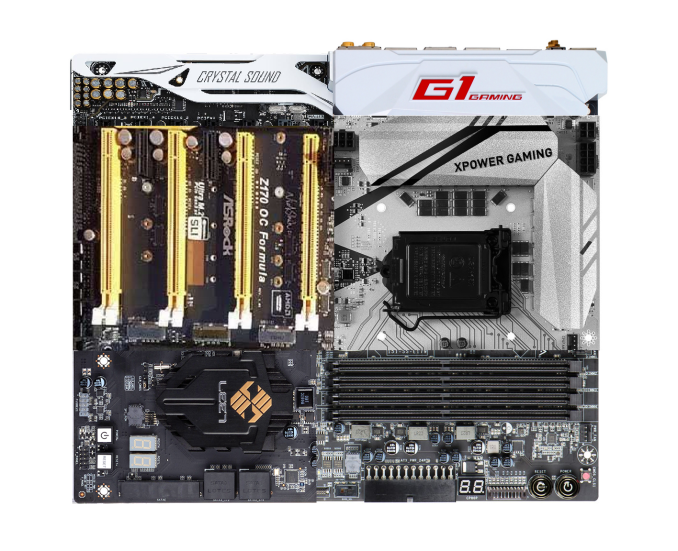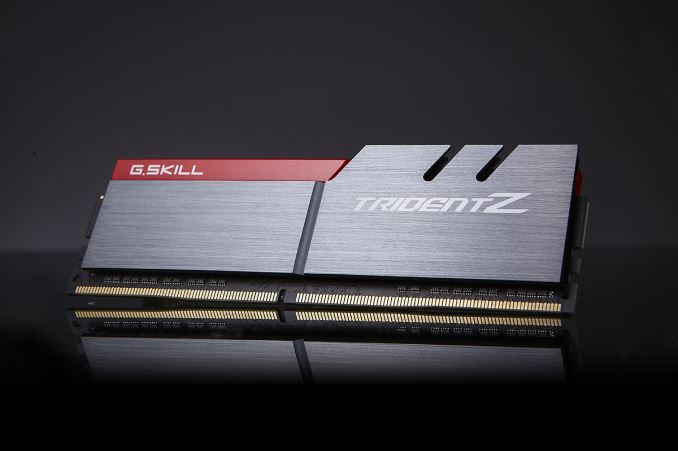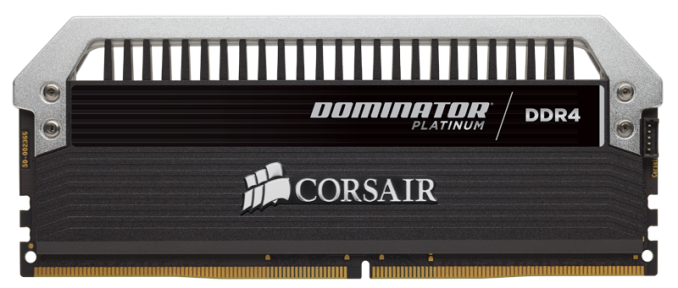The Intel 6th Gen Skylake Review: Core i7-6700K and i5-6600K Tested
by Ian Cutress on August 5, 2015 8:00 AM ESTAlso Launching Today: Z170 Motherboards, Dual Channel DDR4 Kits
The new Skylake processors are assigned a new socket – LGA1151. Intel’s policy since 2006 has been to maintain sockets for two generations and as a result moving from Broadwell to Skylake we were expecting the change. This means that Skylake processors will not work in LGA1150 based motherboards, i.e. those with Intel’s 8th and 9th generation chipsets. For Skylake we get the 100-series chipsets with additional functionality. Launching today in turn is the first member of the 100-series family, the overclocking-friendly Z170, with the other chipsets in the family to follow later in the year.
We have a large piece on the motherboards being released or talked about for Skylake, covering some 55+ products and the different variations within. The major motherboard manufacturers such as ASUS, GIGABYTE, ASRock, MSI, EVGA and a couple of others should all have a wide range ready to purchase on day one, although some models may be region specific.

The badly MSPaint’ed hybrid: MSI’s XPower Gaming Socket, GIGABYTE’s G1 Gaming IO panel, EVGA’s DRAM slots, ECS’s chipset, ASRock’s PCIe arrangement and ASUS’ Deluxe audio.
Here’s an amalgamation of some of the designs coming to end users, with almost all of them investing heavily in gaming brands with specific components to aid the user experience while gaming. Aesthetic designs are also going to be a focus of this generation, with some of the manufacturers moving into a different direction with their designs and trying some new color schemes. Some basic looking models will also be available.
Prices for Z170 motherboards will range from $80 all the way past $400+, depending on feature set and size. A number of motherboards above $150 will feature a couple USB 3.1 Gen 2 (10Gbps) ports, although you will have to check whether they are Type-A or Type-C. That being said, most motherboards with USB 3.1 will use both, but there are a select few that are C-only or A-only. Also over $150 we will see a lot of Intel’s new network controller, the I219-V, although the gaming lines might invest in Rivet Network’s Killer solution instead.
Intel is launching the Alpine Ridge controller at this time as well, which is said to support USB 3.1 Gen 2, Thunderbolt 3, HDMI 2.0, DisplayPort, and DockPort. According to our sources it would seem that GIGABYTE currently has an exclusive on this technology, and it will be used for their USB 3.1 Gen 2 ports on most motherboard models. Other functionality from the Alpine Ridge controller (TB3, HDMI 2.0) will be on a case-by-case basis depending on how the controller works in two different modes or if extra components are used. We are told that Alpine Ridge costs similarly to the ASMedia ASM1142 controller, but will enable two USB 3.1 Gen 2 ports at 10 Gbps simultaneously as it uses four PCIe lanes from the chipset.
We will go more into the 100-series chipset in the next page, but it is worth mentioning briefly here that the speed between the CPU and the chipset has increased from DMI 2.0 (5 GT/s, 2GB/sec) to DMI 3.0 (8 GT/s, 3.93GB/sec), and that the chipset has a new high speed hub (HSIO) that allows 26 lanes to be used from it although some lanes are limited (e.g. 20 PCIe 3.0 lanes maximum split into five x4 controllers). Intel’s Rapid Storage Technology is upgraded as well to give three PCIe drives access to its features as long as they are on the correct HSIO ports.
DRAM: The March to DDR4
In the world of DRAM for personal computers, DDR3 is currently king. Having been the main standard since 2007, you would be hard pressed to find a mainstream or low end platform sold that did not require access to DDR3. That changed in the enthusiast segment last year with the launch of Haswell-E which also introduced DDR4 at a high premium. For Haswell-E there was no crossover – you had no choice but to use DDR4 (unless you might be a million-unit customer).
Because the consumers and consumer product OEMs are more price sensitive, DDR4 will be a slower transition. There is precedent here in that the move from DDR2 to DDR3 saw a generation of processors that supported both standards and it was up to the motherboard manufacturer to design for it. In this transition, Skylake processors will support both DDR3L and DDR4 modules, with a few caveats.
Caveat number one is that initially, only DDR4 motherboards will be on the market. So if you upgrade now, DDR4 needs to be on the shopping list as well. We have had word of some DDR3L-only motherboards coming, as well as combo boards with DDR3L and DDR4 slots on board. Caveat one-point-five, you can use either DDR3L or DDR4, but not both at the same time.
Caveat number two, DDR3L is different to DDR3 as it operates at a lower voltage. This means that the memory controllers on Skylake most likely have a combined voltage domain, and regular DDR3 might not work (in fact early testing suggests not without reducing the voltage). Very few people currently own DDR3L DIMMs, so the likelihood of a user performing an upgrade while reusing their RAM might be slim.
Caveat number three: prices of DDR4 have dropped significantly since last year, and there is only a small premium over DDR3. The benefits of DDR4 include a lower operating voltage, a more stable design, and the ability to purchase 16GB modules with ease. That means that a Skylake platform will happily take 64GB of memory.
With that last point, we should point out that Skylake is a dual memory channel architecture, supporting two memory modules per channel. This gives a maximum of four DDR4 tests, and 4x16 = 64GB maximum.
We have been told that Skylake’s memory controller, compared to previous generations, is absolutely golden at higher speed memory support. By default Skylake supports the JEDEC standard for DDR4, 2133 MT/s at a latency of 15-15-15, but the overclocking guides we have received suggests that all processors should be able to reach DDR4-3200 relatively comfortably, with a few processors in the right motherboards going for DDR4-4000. While this should bode well for integrated graphics users, those high end kits are typically very expensive.
We currently have dual channel kits in to test from a number of the DRAM companies, and plan on performing a memory scaling article within the next few weeks to see how exactly performance might scale on Skylake. Though in the meantime, as part of this review, we were able to source a closed beta variant of a combination DDR3L/DDR4 motherboard for Skylake and have included a test comparing the two.












477 Comments
View All Comments
DanNeely - Wednesday, August 5, 2015 - link
Reliability might start to be a concern in the next year or two. I had a 920 and a 930 (bought right after release and about a year later); but back in June the 920 stopped POSTing. Since I did a precautionary upgrade to a 4790K at the start of the year it didn't impact me; and I haven't gotten around to doing any part swaps to figure out which component failed yet. (Not so I can buy a replacement part; but so I know what's potentially usable as a spare if/when the 930 does the same.)06GTOSC - Wednesday, August 5, 2015 - link
Looks to me that I'm not missing anything for gaming by staying with my 4790k.nmm - Wednesday, August 5, 2015 - link
Well, that was a bit underwhelming. Fantastic article, of course, but I can't agree that this is a nail in the coffin for Sandy Bridge. For myself, I think I'll just upgrade the cooler on my i7 2600k and bump the multiplier up a few notches and hold out for another year. When there are some reasonably cheap NVME options and affordable/fast high capacity DDR4 modules and Pascal GPU's, that will probably be the right time for me to break up with Sandy.piroroadkill - Wednesday, August 5, 2015 - link
Definitely not the nail in the coffin for Sandy, far from it.In games, there's still no point to upgrading..
Jon Tseng - Wednesday, August 5, 2015 - link
TBH I'm not missing anything staying with my QX6850! (65nm FTW). GPU is all that matters nowadays...postem - Wednesday, August 5, 2015 - link
That was my doubt when i was up to wait 6 months or get DC to replace old 950. The difference is mainly negligible from DC, but there will be much more costly due to new mobos, DDR4 and so on.kenansadhu - Saturday, August 8, 2015 - link
Were you really thinking about upgrading to skylake when you bought your 4790k?Refuge - Wednesday, August 5, 2015 - link
I wanna know whats going on under the hood. Can't wait for the follow up article.Otherwise I'm disappointed, if you claim this is the end for Sandybridge, then anyone who agree's and is upgrading lemme know, I'll gladly take your old hardware for cheap.
With this performance I'd be happier buying a Devilscanyon for less and wait for Intel to actually give me something worth spending $220+ on.
Skylake, I am very disappoint.
otimus - Wednesday, August 5, 2015 - link
Says "Sandy Bridge, your time is up" proceeds to practically show data as to why it is not. Especially for gaming.Do you guys just not live in reality, or does getting things for free just flat out cloud your mind to the staggering cost it'd take to go from Sandy Bridge to Skylake for what seems like a very few FPS? Even worse, I imagine most folks are still on 60 Hz monitors.
Refuge - Wednesday, August 5, 2015 - link
I have a lot of respect for you Ian, but I completely disagree that Sandy's time is up, and if it is? Skylake isn't the cause. This is such a terrible release haha. I hope it is just some launch kinks that need ironed out.Otherwise Devils Canyon is where its at. Older gen so it is cheaper, and it is more compelling than this slab of silicon. Other than increased iGPU performance with DDR4 memory, there isn't a single gain I saw in any of these benchmarks that is noticeable to an end user.